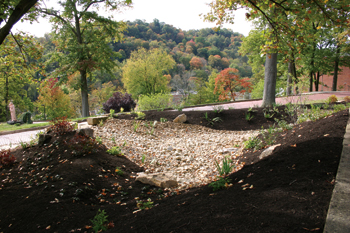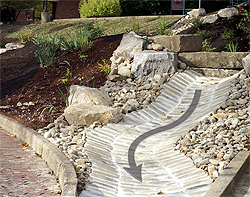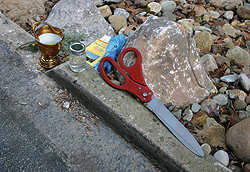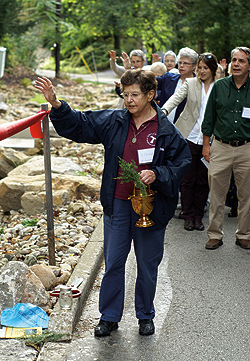Partnership Looks Beyond Trees for Storm Water Management
In early spring, when the snow melts and the Pittsburgh metropolitan area gets an average of 10 inches of rain in three months, some residents’ attention turn to soggy yards, wet basements and other flooding woes.

Bioswales capture storm water close to the source, reducing roadway flooding, ponding and sewer overflows.
Photo courtesy Sisters of St. Francis of the Neumann Communities
In the borough of Millvale, Pa., just outside of Pittsburgh, this is especially true. Located at the confluence of Girty’s Run and the Allegheny River, a large portion of the borough is located in a floodplain. Storm runoff and snow melt often cause flooding there; the location is particularly impacted because of the impervious surfaces added by residential and business development upstream.
TreeVitalize Pittsburgh, a public-private partnership managed by the Western Pennsylvania Conservancy, has helped to address the flooding issues in Millvale since 2012, when it began planting hundreds of street trees there. But the partnership turned to a new tactic when it orchestrated the construction of two storm water management systems, called bioswales, in an especially flood-prone area of Millvale. TreeVitalize unveiled the bioswales on the Franciscan Sisters of Millvale’s campus in October; the first spring rain will hit the catchments this season.

Photo courtesy Sisters of St. Francis of the Neumann Communities
“This is really a natural progression for TreeVitalize and the Conservancy as we look for the most efficient ways to control storm water,” said Jeffrey Bergman, the director of TreeVitalize Pittsburgh. “This is a large-scale project and we’re hoping for an impressive improvement in the area.”
Bioswales are built landscape elements designed to control and filter surface and storm water runoff. Often constructed near roads and parking lots, these structures are typically wide, shallow depressions containing soil, native vegetation and slopes that are steep enough to prevent ponding, yet gentle enough to encourage filtering.
In the case of the bioswales near the Sisters of St. Francis’ Mount Alvernia motherhouse, a smaller depression is located just off a parking lot close to the hilltop building and the other bioswale stretches along a road on a steep hill leading away from the Sisters’ campus. Hawthorn Road is prone to flooding and heavy rains have often gushed down the street, flooding the basements of the houses at the bottom of the hill, said Sister Donna Zwigart of the Sisters of St. Francis.

Photo courtesy of Matthew Little
The Hawthorn Road bioswale is about 15 feet wide and 400 feet long and contains a mix of rocks, boulders, soil, trees and other native plants, all dotted along a slope that has an 8 percent grade. Hidden among the landscaping – designed to look like a natural stream with riffles and pools – are weirs and a raised drain that carries away the water.
The structures were designed by Arthur Gazdik of Groundwork Civil LLC and constructed by Best Feeds Outdoor Design of Pittsburgh. Project partners include the Borough of Millvale and the Sisters of St. Francis, a congregation named for the patron saint of animals and the environment.
“St. Francis was an environmentalist. They didn’t call him that back then,” Sister Zwigart said as she blessed the bioswales with holy water and a hemlock branch at a curb–cutting ceremony – a twist on the traditional ribbon cutting – last October. Partners unveiled the structures to a crowd of about 100 residents, community leaders and others.

Sister Zwigart blessed the bioswales with holy water and a hemlock branch at a curb–cutting ceremony cutting last October.
Photo courtesy of Matthew Little
The second bioswale that sits near a parking lot includes native plants and trees such as horse chestnut, autumn flowering cherry and bald cypress. Sister Zwigart hopes the residents of the campus and the children in the site’s daycare center will enjoy the garden-like nature of the bioswale.
Financial support for the bioswales came from a grant from the Pennsylvania Infrastructure Investment Authority, also known as PENNVEST.
The bioswales are part of a multi-year project in Millvale in which WPC – the managing partner of TreeVitalize Pittsburgh – planted 850 trees throughout the borough. While TreeVitalize and the Conservancy will care for the bioswales and the trees for about two years, the project will train volunteer tree tenders to be eventual caretakers.
TreeVitalize is a partnership among WPC and Allegheny County, the City of Pittsburgh, Tree Pittsburgh and the Pennsylvania Department of Conservation and Natural Resources (DCNR), which is also one of the initiative’s top funders.
Thanks to funding from the Allegheny County Conservation District, the partners will monitor the catchments for about a year to better understand how much water is captured during a flooding event.
Judy Wagner, senior director of the Conservancy’s Community Gardens and Greenspace Program, hopes that the Millvale bioswales will be an inspiring model for other communities and, in fact, the whole ALCOSAN district to demonstrate the value of green infrastructure to support storm water management in urban settings. “This is a terrific model for communities who would like to apply green infrastructure to their local needs.”
